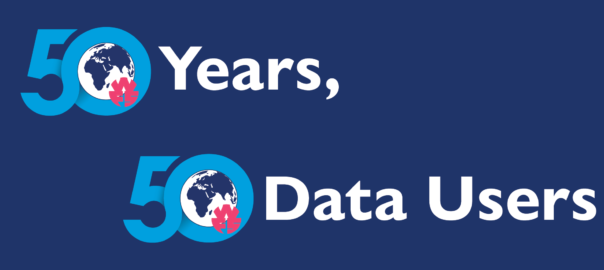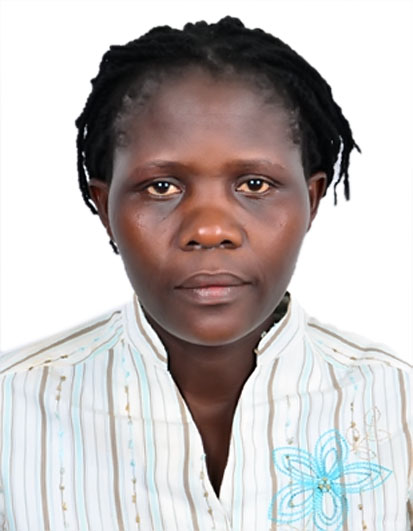50 Years, 50 Data Users: Improving Maternal and Child Health using WFS and DHS Data

Since the beginning of 2022, The DHS Program has been celebrating USAID’s 50-year commitment to high-quality data collection, evidence-based decision making, and local country ownership of health and demographic information, first through the World Fertility Survey (WFS), 1972-1984, and since 1984 through The DHS Program.
Throughout the year, we are proud to feature a selection of 50 program managers, policy makers, journalists, researchers, and others from across the globe who use WFS and DHS data. Read about the first 10 data users and the second group of 10 data users if you missed them, and today we bring you the third installation. Meet the newest group of featured DHS data users below!

Dawit Tessentu (Ethiopia)
“If not for DHS data, it would be difficult to get timely and quality data to monitor our progress and development in health“
Dawit Tessentu (Ethiopia)
Current role: Senior Statistician/Demographer, Ethiopian Statistical Service
How I have used WFS/DHS data: I have used DHS data to write various reports on the Ethiopian population and health conditions. I was part of the team that wrote the 2011 Ethiopia DHS,2016 Ethiopia DHS, and 2019 Ethiopia Mini DHS reports.
DHS data have been used in Ethiopia to monitor SDG goals and indicators and to formulate and monitor health policy and programs. I have written several papers exploring specific indicators that are helping us reach our SDG goals.
DHS data have a huge impact on global health and development by monitoring health program improvements and progress over time. DHS data are also helping Ethiopia to make evidence-based decisions to improve health outcomes.

Cristina Bradatan (United States)
“There is no other program that provides similar quality data for low-income countries. Without DHS Program datasets, any policies and funding for development would have been based on wild guesses“
Cristina Bradatan (United States)
Current role: Demographer, U.S. Census Bureau, Texas Tech University
How I have used WFS/DHS data: I first came across DHS data while in graduate school in Romania. I have used the DHS to analyze the effects that abortion bans have on fertility and reproductive health. Later, I used several Bangladesh DHS datasets linked with climate data to analyze the effects of climate change on women’s nutritional status and children’s health. I also used Honduras DHS data to study the effects of rain and temperature changes on children’s health.
Survey countries often use DHS data to do their population projects. I see this in my work at the U.S. Census Bureau International Programs Center, as we often provide technical support to low-income countries. Our own projections database at the Census Bureau, a tool that has been accessed millions of times all over the world, makes use of the DHS Program datasets.

Papy Ansobi (Democratic Republic of Congo)
“Having access to reliable demographic and health information from The DHS Program allows us to plan wisely for the well-being of our population“
Papy Ansobi (Democratic Republic of Congo)
Current role: Master en Ecoépidemiologie, Université de Kinshasa
How I have used WFS/DHS data: DHS data have made it possible for me to develop several papers about women’s and children’s health. Data from The DHS Program were used to assess MDG indicators. The data also allowed the DRC to develop and strengthen programs in family planning and for training births assistants. I often refer to DHS data online in my research.

Tewa Kamano (Guinea)
“Without important DHS data about trends of various indicators, we would not know what works and what doesn’t, which could have grave consequences on the population“
Tewa Kamano (Guinea)
Current role: Public Health Officer, National Public Health Institute
How I have used WFS/DHS data: I studied Public Health at the International School of Public Health, Université Mohamed VI des Sciences de Santé in Casablanca, Morocco. I used DHS data from Guinea for my thesis on sexual and reproductive health. For example, I learned that the percentage of women who had a postnatal exam went from 37% in 2012 to 49% in 2018. With this information, we can study what led to this improvement and how we can continue the trend. Looking at Final Reports, datasets, and other DHS Program tools, we can make informed decisions moving forward.

Willy Ney Otañez Reyes (Dominican Republic)
“My favorite way to access and use DHS data is through STATcompiler. This platform is very easy to use and is very versatile”
Willy Ney Otañez Reyes (Dominican Republic)
Current role: Survey Department Chief, National Statistics Office
How I have used WFS/DHS data: : I frequently use data from the seven DHS surveys that have been carried out in the Dominican Republic to evaluate the consistency and reliability of the information that the National Statistics Office obtains through household surveys. Also, I use the data to analyze estimates and projections of demographic indicators.
The DHS Program has been the source of information par excellence to respond to the demand for information needed to plan and evaluate public policies in the health sector in the Dominican Republic.
Worldwide, The DHS Program has contributed to improving health and living conditions because the data are key to identifying vulnerable groups and, in turn, to making more efficient use of economic resources allocated to public health policies.
My favorite indicator from The DHS Program is the total fertility rate because it is the indicator that I consult the most to evaluate demographic estimates and projections. Without The DHS Program, the health situation would be worse, especially in the poorest countries. Given the limited health statistics information systems in these countries, public policies to improve health problems would be unfeasible.

Vandana Tamrakar (India)
“Without DHS data, tracking progress and real-time monitoring would be a real challenge, especially for low- and middle-income countries”
Vandana Tamrakar (India)
Current role: Project Research Scientist, Division of Prevention Oncology and Population Health, WHO Global Knowledge Hub on Smokeless Tobacco, National Institute of Cancer Prevention & Research, Indian Council of Medical Research, Ministry of Health & Family Welfare
How I have used WFS/DHS data: I used data from 1987-2018 for selected South Asian countries (Bangladesh, India, Nepal, and Pakistan) in multiple DHS survey rounds for my PhD dissertation, “Trends and Determinants of Gender Differential in South Asian Countries.”
I have a keen interest in child mortality and family planning services, especially in how they change over time and vary across regions. Child mortality is an important benchmark of a country’s health status in achieving its SDGs. I have presented many research papers in national and international conferences using DHS data. As a demographer and population researcher of The DHS Program, I have encouraged several social scientists to use DHS data for their research.
The DHS datasets are extremely useful for researchers, social scientists, policymakers, planners, and civil society organizations to monitor and evaluate their progress. One of my favorite DHS new tools is the app to use raw Stata files and link them with GPS coordinates for geospatial analysis on population health. Other useful tools that I use on a regular basis are STATcompiler, the DHS Program Mobile App, and the many analytical and methodological reports available on The DHS Program website.
My team recently wrote two articles that use DHS data: “Trend and the Pattern in Excess Female Under 5 Mortality in India, 1987-1993 – 2010-2016,” preprint for The Lancet; and “District level correlates of COVID-19 pandemic in India during March-October 2020” in Plos One.

Austin Gumbo (Malawi)
“I am convinced that DHS data has helped us improve the overall well-being of our population”
Austin Gumbo (Malawi)
Current role: Monitoring and Evaluation Manager, Malawi National Malaria Control Program, Ministry of Health
How I have used WFS/DHS data: I have used DHS data for making decisions in my work. Low use of intermittent preventive treatment in pregnancy (IPTp) led us to try new ways of increasing coverage. We conducted a community pilot project using DHS data that included a malaria behavior survey and observations of misuse of long-lasting insecticidal nets (LLINs). We developed innovative interventions to improve IPTp and we engaged Traditional Authorities to help change behaviors around the proper use of nets.
I access DHS data via the website (online publications) and on STATcompiler. It’s good to have all the information in one place and STATcompiler is easy to use and comprehensive. Malaria prevalence is my favorite indicator because it directly demonstrates the impact of the malaria interventions we implement.

Sylvia Meku (Tanzania)
“DHS data are the most requested data at the Tanzania National Bureau of Statistics”
Sylvia Meku (Tanzania)
Current role: Coordinator, Social Statistics, Tanzania National Bureau of Statistics
How I have used WFS/DHS data: How I have used WFS/DHS data: I have worked with The DHS Program to conduct surveys for many years in Tanzania. I was the Project Coordinator for the 2014-15 Tanzania SPA, Project Manager for the 2015-16 Tanzania DHS/MIS and Project Coordinator for the 2017 Tanzania MIS. DHS data are the most requested data in the National Bureau of Statistics. Planners and program managers use DHS data for monitoring and evaluating health policies related to reproductive health, fertility, and health services. They are also popular among researchers at academic institutions throughout the country.
My favorite DHS Program tool is STATcompiler.

Kenneth Hill (United States)
“From an initial skeptic of WFS to an avid lifelong user of birth history data”
Kenneth Hill (United States)
Current role: World expert in maternal and childhood mortality has used WFS/DHS data throughout his career
How I have used WFS/DHS data: The World Fertility Survey was just getting under way when I was completing my graduate studies at the London School of Hygiene and Tropical Medicine. My initial use of WFS/DHS data focused on the summary birth history (children ever born, children dead by age of mother) that were an essential precursor to collecting the full pregnancy history data.
Most of my work using WFS/DHS data has been about infant and child mortality, even though I presented a paper on estimating fertility trends using WFS and other data at the 1982 Proceedings of the World Fertility Survey Conference. From then on, I used WFS, DHS Program, and other data primarily to estimate trends and differentials in childhood mortality in low- and middle-income countries (LMICs). In the late 1980s the National Academy of Sciences’ Committee on Population’s Panel on the Population Dynamics of sub-Saharan Africa used WFS/DHS data in all its reports. For the World Bank’s 1993 World Development Report, colleagues and I started compiling a country-specific timeline of estimates of mortality under age 5, an exercise that transitioned into the ongoing work of the Inter-agency Group for Child Mortality Estimation in the early 2000s.

Dinah Amongin (Uganda)
“Without DHS data, many countries would be left in limbo, with no way to know what the trends are in important public health matters”
Dinah Amongin (Uganda)
Current role: Lecturer, Makerere University
How I have used WFS/DHS data: I conducted my PhD research using Uganda DHS data going all the way back to 1988. My dissertation, “Understanding trends and trajectories of repeat adolescent birth in Uganda,” focused on shedding light on the magnitude of second or higher births before women aged 20 with first birth at 18 years or younger. Whereas first birth in adolescence had received some attention, repeat adolescent births had not. Data from The DHS Program was the only available source that could enable us to study trends in this important public health challenge that had not yet been investigated in Sub-Saharan Africa. The results from my quantitative and qualitative analyses have been used by the Ministry of Health when reviewing policies on adolescent health Discussions of re-entry of adolescent mothers into school, especially following an increase in teen pregnancies due to the COVID -19 pandemic school closures, have drawn on these results.
The DHS has provided countries that lack national databases an avenue to have nationally representative data that drives policy decision making. This has enabled critical comparisons to be made between them and countries with advanced national registration systems.
Nominate Yourself or Another Data User to be Featured
Have you used WFS or DHS Program data to develop or implement policies, programs, and projects in low- and middle-income countries? Have you used WFS or DHS Program data in your research? Do you know someone who champions WFS or DHS Program data use in their work? Nominate yourself or someone else by filling out a brief form and you may be chosen to be featured as one of 50 data users.
¿Conoce a alguien que promueva el uso de los datos del Programa DHS en su trabajo o investigación? Nomínelo para que figure como uno de los 50 usuarios(a) de datos para celebrar los 50 años de datos del Programa DHS y de la Encuesta Mundial de Fecundidad.
Connaissez-vous quelqu’un qui encourage l’emploi des données du DHS Program avec leur travail ou recherche ? Proposez sa candidature d’être l’un des 50 utilisateurs de données sélectionnés pour célébrer 50 ans de données.

